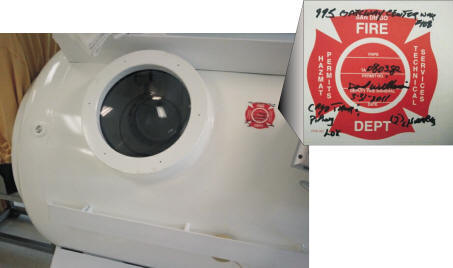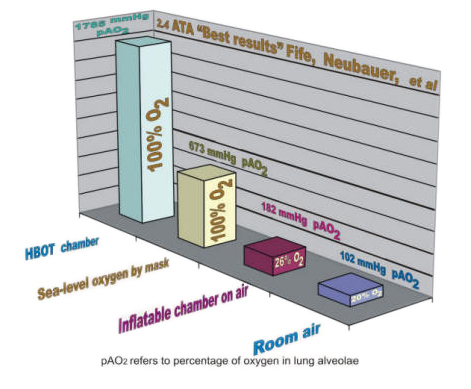Hard science dispels the myths about oxygen. For example, denim jeans and high quality tee-shirts offer better fire protection than loose weave 100% cotton scrubs.
There has been much loud and often vitriolic debate over which type of bag is the “safest” – the soft sides inflatable chambers or the hospital grade “hard” chambers.

Both chambers are equal in their ability to produce a life-threatening fire. Since oxygen will not ignite (“explode”) when exposed to a flame, the use of either – by professionals or home-care owners and renters – require training, special precautions and alert-watchfulness by the operators.
HYPERBARIC OXYGEN THERAPY (HBOT) IS EXTREMELY SAFE
At least one million HBOT treatments are given each day in the U.S. and there has only been one fatality during HBOT’s 50-year history in the United States. Compare that with the 70,000 patients that die in U.S. hospitals each year from “complications” during surgery.
All Clinics and Centers associated with Sands chambers only use ASME-PVHO-1 chambers. In addition, the Series III Clinical monoplace chambers are the only single-person chambers capable of being equipped with fire suppression to Class A chamber standards.
All associated centers are in the process of retrofitting all Series III monoplace chambers with fire suppression.
Clinics are required to be code compliant, have high staff training levels and practices, strict safety procedures and only use the most modern and cutting edge equipment.
Many parents and caregivers are confused about the claims made by proponents of inflatable chambers, especially since much of the data used by practitioners to justify their use comes from a different type of chamber that provides 100% oxygen at higher pressures.
To achieve the results of Doctor Richard Neubauer and Dr. Paul Harch in the treatment of challenged children, almost double 100% sea-level oxygen is required and this can only be accomplished in conventional "hard", 100% hyperbaric chambers. Clearly inflatable chambers only deliver marginal oxygen percentages over breathing room air.
Notwithstanding, a number of respected medical specialists claim to get similar results with their neurologically challenged patients by treating them in inflatable mHBOT chambers. However, our Centers treated a number of patients that had already undergone dozens of treatments in inflatable mHBOT chambers with no observable quantitative or qualitative positive changes. After being treated in our conventional (hospital quality) "hard" HBOT chambers, these young patients showed dramatic gains.
Before making a commitment to be treated in an inflatable chamber, obtain satisfactory answers to the following questions from your prescribing practitioner … remember, he or she must be a registered physician – M.D., D.O.
Any medical center (hospital, clinic, doctor’s office) that uses hyperbaric chambers of any sort (e.g. compress gas over 2 psig) must comply National Fire Protection Agency (NFPA) 99-11 codes with fire walls and certified fire doors, sprinklers and other code compliance.
• Does the Center you choose comply with the local Fire Marshal’s codes and the City’s HAZMAT requirements?
Some parents have reported that their children became “asthmatic” and had breathing difficulties after mHBOT treatments.
• If these reports were accurate, could this be caused by inadequate air filters on the inflatable chambers compressors, failing to provide medical grade compressed air and failing to filter out mold spores, bacteria and dust from the doctor’s office?
100% oxygen pressures less than 1.3 ata (4.4 psig) promotes the growth of aerobic bacteria in injured tissue within the body.(4) Pressures in “hard” (hospital grade) chambers have to be increased to to sufficient levels for oxygen to become bacteriostatic.
• Are some young patients suffering from an increase in bacterial and candida albicans (facultative anaerobe) proliferation problems because of the lower pressure and oxygen percentages of mHBOT?
If the answers to the previous questions show no negative problems from mHBOT, does the tiny increase in oxygen percentage obtained in mHBOT produce quantitative and qualitative gains for the patients?
The graph above clearly shows that a mask or hood at sea level delivers approximately four times more oxygen that mHBOT.
• Since it is easier and less costly to increase oxygen percentages in other ways (e.g. nasal prongs, oxygen masks, hoods, etc), can these alleged positive results be duplicated at home without using an mHBOT inflatable chamber?
It is likely that trials will be undertaken to compare the effects of both sorts of chambers and even to ascertain whether other low cost oxygen alternatives will provide the same benefits to patients as inflatable mHBOT chambers.
 Our Centers do not use nor sponsor the use of mHBOT inflatable chambers for a number of reasons — Laws of Physics do not support the claims of mHBOT advocates. However, ongoing research demonstrates gains in Autistic and CP patients. For more information on the laws of physics that apply to HBOT …
Our Centers do not use nor sponsor the use of mHBOT inflatable chambers for a number of reasons — Laws of Physics do not support the claims of mHBOT advocates. However, ongoing research demonstrates gains in Autistic and CP patients. For more information on the laws of physics that apply to HBOT …
National Fire Protection Codes
National Fire Protection Codes mandate that all chambers used in a medical setting are certified by the American Society of Mechanical Engineers – Pressure Vessels for Human Occupancy – Level 1 (ASME-PVHO1)
Inflatable chambers are not code-compliant with PVHO-1. If the State where they are being used is a PVHO-1 State (e.g. California) it is illegal to sell or use these “soft” bag chambers in a “professional” medical environment.
Therefore, the local Fire Marshal has the ability to close down any medical office that is already using inflatable chambers. (Eleven States and three U.S. cities are now enforcing the PVHO-1 codes and scrutinizing health care practitioners who advertise for patients.)


